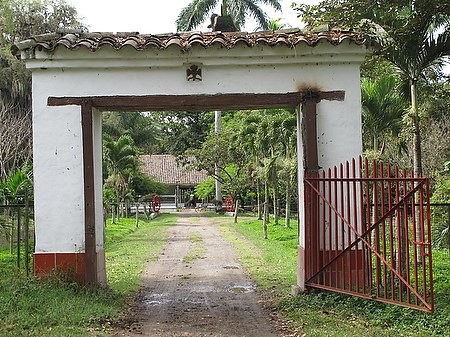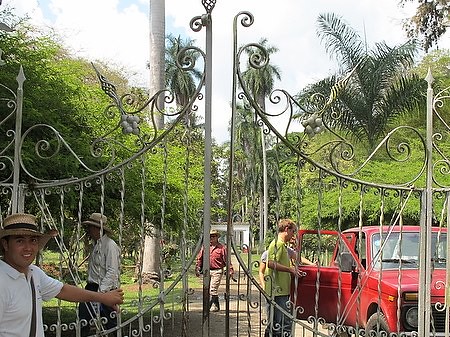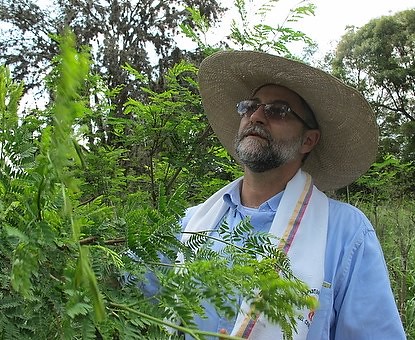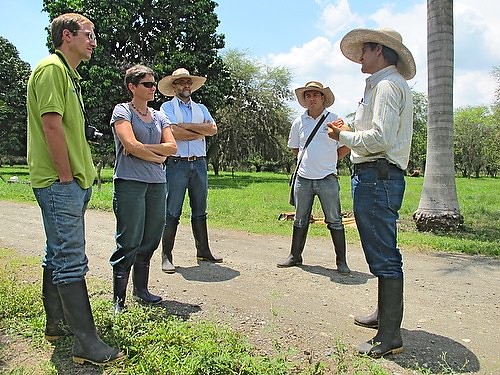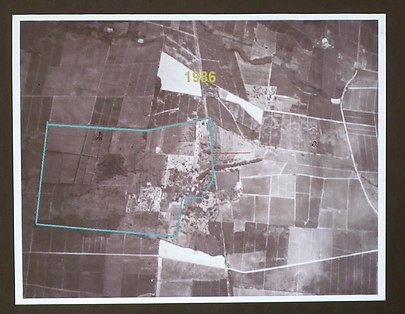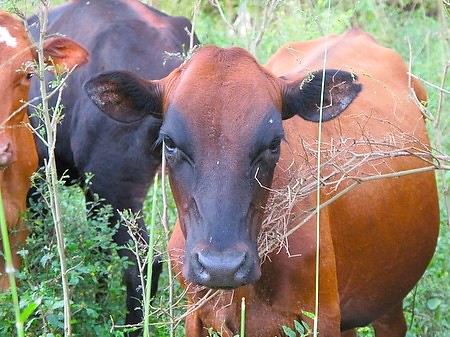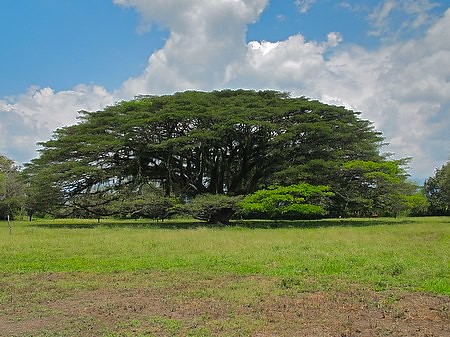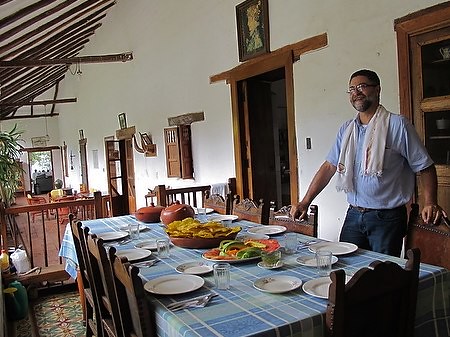VALLE DE CAUCA, Colombia – When Alicia Calle, an environmental scientist with Yale’s Environmental Leadership and Training Initiative, first told me of El Hatico Nature Reserve, her face lit up for the first time since I’d met her an hour ago. We’d been talking about the state of the environment in Colombia, a subject with much to lament, given the spread of mining operations, cattle ranching, vast monocultures of sugarcane and African palm and coca, deforestation, water contamination, the same story throughout the Americas.
What is it that gives you hope, I asked her, as I do in every interview. It was then that she pulled out a booklet and started showing me photos of El Hatico.
“Let me be clear: I don’t like cattle farming; I think it’s created terrible environmental problems and social inequalities throughout its development in Latin America. But this is a place I’d really like you to see, a place that’s turned a major problem into a part of the solution.”
I looked at the photograph and thought I was seeing my grandfather’s farm in the Missouri Ozarks: clusters of russet-colored cattle peacefully grazing among shady forests of mature trees. Nothing like the razed expanses that stretched to the horizons, cattle farms I’d seen throughout the Guatemalan Peten, the Argentine Chaco, in rural Mexico and Paraguay.
Cattle farmers have cleared millions of acres of rainforest and tropical dry forest to create fields for cattle, releasing untold tons of carbon into a steadily heating atmosphere, causing a wave of droughts and erosion, eliminating wildlife habitat and degrading the rivers that flow through. An estimated 27 percent of Colombian land is now used for cattle production, and deforestation continues at the aggressive rate of 300,000 hectares a year, according to an article coauthored by Calle and others published this month in the prestigious professional journal Forest Ecology and Management.
El Hatico, a nine-generation family farm that has become an oasis of biodiversity among the sugarcane deserts of the Cauca Valley in Southwest Colombia, chose a different path, and finally, industry and government leaders are beginning to take notice. Now, according to Calle, the El Hatico model is being replicated around the country through a new government program, and other countries are watching to see the results.
That’s how I found myself riding shotgun with Alicia’s sister, Zoraida, making our way through miles of sugarcane fields as she told me a bit of El Hatico’s history.
“We’re at a very exciting moment in the development of this system,” Zoraida was telling me. As a specialist in ecological restoration with CIPAV (Center for the Investigation of Sustainable Agropecuarial Systems), she sees Hatico and its Intensive Silvopastoral Systems approach to cattle farming as a key component in the restoration of tropical forests. She has dedicated 19 years to this project, and has never seen the receptivity that has opened up in the past year.
“Every week we’re receiving visits from two or three Mexican producers; we’re seeing farmers from Nicaragua, Panama, Brazil, Cuba and Argentina. They want to see how it’s possible to do what they are doing.”
Conventional cattle farming requires the application of 80 to 100 kilograms of urea fertilizer per hectare per year, costly imported fossil fuel-based fertilizers that create runoff into regional streams, degrading water quality and suppressing the fish populations. The tropical forests that once stretched the length and breadth of the Cauca Valley were felled more than a century ago for lumber and many hectares were converted to cattle farms; since then, the more lucrative business of sugar has supplanted most of the cattle, with even greater environmental impacts because of widespread herbicide and pesticide use.
Finally we are leaving the monochromatic landscape of cane and entering a promenade of graceful saman trees. An enormous bird swoops across the road in front of us, as if to welcome us to its world – a garrapatero, or tick-eater, Zoraida tells me, English word here – “These birds are almost extinct in the Cauca Valley – but here they have a home.”
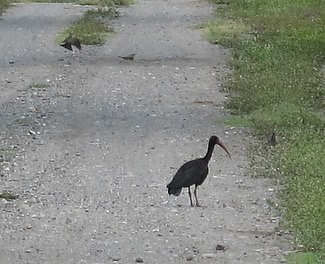
A flock of black ibises with their curving red beaks flutters by and lands on the lush grass in the forest at our left. A cluster of white cattle egrets alights amid the roan-colored cattle to our right.
“Oh, look, it’s a cocli,” exclaims Zoraida as a huge and magnificent pair of birds lands in a field along the way. These birds are also nearly extinct in the region.
We have arrived in El Hatico.
We pull up to an elegant iron gate and Carlos Molina is there to greet us, the eldest of eight brothers who tend the heritage of their grandfathers and serve as agroforestry educators, agronomists and entrepreneurs. A tall, handsome man with an easy smile under his broad-brimmed straw hat, he’s delighted to learn of my grandfather, the agroforestry pioneer, and my mother, the organic farmer, and we connect immediately.
My grandfather passed away in April, and since then I have felt his presence with me strongly – especially on this day, as I invited him along for the ride. I think he was pleased with what he saw.
Carlos showed us around the house first, a graceful relic from the late 1700s whose terra cotta tile roof had survived its 230 years with little damage, but some of the beams were beginning to bow, and workmen were carefully disassembling it, replacing the bowed segments and marveling at the integrity of the original structure.
“Look at this piece of palm,” Carlos said, shaking his head in wonder. “Just as strong as it was 200 years ago.”
The same could be said for this family and its farm, which has held together through two centuries of revolution and armed conflict, drug wars and economic crises and climate crises, an oasis amid the storms.
Soon we were joined by another of the Molina brothers, the equally charismatic Enrique, along with an agronomist and an environmental educator from Costa Rica who had come to tour the farm as well.
“The problem of the defense of the forests is of anguishing seriousness and the most terrible threat to the future of the region,” wrote Enrique and Carlos’ grandfather, Ciro Molina Garcés, in 1937.
By 1942, vast expanses throughout the region had been cleared by logging and cattle operations, as we see in the aerial photos that begin our presentation. By 1986, the landscape had been converted to a patchwork cane farms. Only the dark patch of Hatico remained as forest.
Today El Hatico is a mixed-use farming operation; 32 percent is organic sugar cane; only 5.5 percent is pure hardwood forest, but another nearly 9 percent is native bamboo forest, while 12.7 percent is under what is called SSPI, Intensive Silvopastoral System by its Spanish acronym, and this is the part that is being closely watched by industry leaders.
“When we talk to agricultural producers, they look around and say, oh, this isn’t good. Our fathers and grandfathers taught us you have to cut the trees down,” Carlos said. “But I tell them, look around; see for yourselves. We have 80 percent canopy cover here, and look at the quality and quantity of this grass. And this is with zero chemical inputs. Conservation and production do not compete; they work together.”
In terms of cost, the El Hatico balance sheet comes out shining. Due in part to improved production and in part to a greatly decreased cost in inputs – zero agrochemicals, zero soy supplements for the animals because of the higher nutritional value of their grazing plants, and greatly reduced irrigation costs and the associated electricity bill – El Hatico shows that conservation is good business.
In addition, the Molinas are positioning themselves to receive payments for the environmental goods and services they are providing, should such payments ever become available: carbon fixation, oxygen production, hydrogen cycle regulation, productive capacity of the soil and conservation of biodiversity.
But what really captured the attention of industry leaders was the production at El Hatico during the drought of 2009-2010, brought on by El Niño, which devastated producers throughout Latin America. In 2009, El Hatico actually had higher production than the year before – a result that was virtually unheard of throughout the industry. “And this was without irrigation,” emphasized Carlos.
Now it was time for the tour. Carlos and Enrique led us out the cast-iron gate and down the shady lane, where a pair of magnificent coclis were grazing in the tall grasses nearby. Enrique spoke of the challenge of transferring the family’s values to each new generation in an era when most young people leave the farm for other opportunities in the cities.
Here at El Hatico, each child on his or her third birthday is placed on a horse for their first horseback ride. The horse continues to be a tool to connect the children with the farm, and on their first communion they are presented with a small mare.
“It creates a sort of an addiction,” Enrique explained, “but a healthy addiction – it sensitizes them to the family heritage. These three elements – equine, human and natural environment – are a supremely beautiful way to provide environmental education for the children.”
Indeed, the tour of the entire farm is a supremely beautiful educational approach for all of us. The next stop is the under the enormous spreading branches of the grandfather saman tree that Carlos and Enrique’s father planted 70 years ago and has become a symbol of the farm.
Much of the resistance to agroforestry for grazing comes from the idea that broadleaf plants are a weed and must be eliminated, Carlos explains. In fact, shade eliminates the most problematic broadleaf plants, and the native plants provide good, high-protein forage – “so the ‘maleza’ becomes a ‘bueneza,’” he jokes, using a play on the Spanish word for weed (maleza = weed, mal = bad, Buen = good).
Back on the lane to the highway, a flock of fulvous whistling ducks takes flight and the visitors grab for their cameras. I realize I’ve seen more birds here at El Hatico than I’ve seen on several birdwatching expeditions during my journey.
I learn many things on this tour; one is that mesquite is actually excellent cattle forage, especially as it’s drought-resistant – a fact that could prove quite useful in Texas.
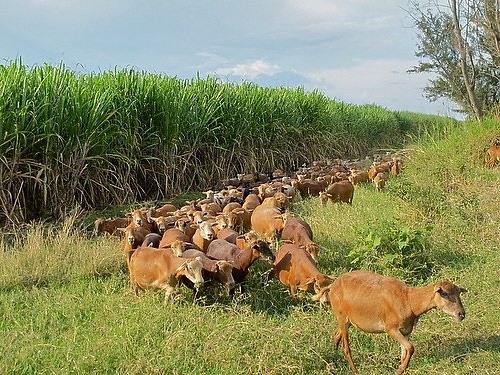
Another is that organic sugarcane can be just as profitable as its chemical-assisted counterparts, and can be companion-planted with other crops. Part of the Molinas’ sugarcane work crew was hard at work when we arrived: a flock of sheep, grazing on the weeds that grow up between the rows, eliminating the need for herbicides. When they first began experimenting with the sheep as a means to control weeds, they were very careful to use moveable fences to protect the fledgling cane plants from the animals. One day, however, the fence got knocked down, and the pastor observed, to his surprise, that the sheep didn’t touch the cane – only the broadleaf plants around and between the rows.
In the beginning, the neighbors worried that the sheep would escape and create havoc in their fields. Now, Enrique says, they’re getting a different type of phone call from the neighbors, who want to borrow the sheep for weed removal in their own parcels: “’Send in the contractors!’ they say.”
Perhaps more importantly is the Molina’s alternative to the slash-and-burn approach to waste management that predominates throughout the industry. At the end of each growing season, most cane producers burn their fields, leading to air pollution, vast amounts of carbon pouring into the atmosphere, and destruction of healthy soil ecology, requiring more chemical inputs for the next crop.
Instead of burning, the Molinas use their cane waste to produce a ground-protecting mulch that is returned to the soil with each new season. This biomass is laid between rows and protects the soil moisture, drastically cutting down on the need for irrigation, Carlos explains. He picks up a handful of the brown grassy mass in the irrigation ditch and wrings a stream of water from it to demonstrate its capacity to hold water.
“This was the system we used until the 1960s, when they started burning – because that’s what they used in California and Hawaii,” he explained.
Under normal conditions, it costs a cane grower $300,000 per hectare per year to irrigate, Carlos said. The Molinas were able to irrigate their fields for much less.
Nowadays, Carlos says, visitors to the farm leave enthusiastic about making a transition on their own farms. “People no longer see us as romantics,” he says. “They see us as pragmatics.”
The sun sets quickly here in the tropics, and the insects and treefrogs sing a farewell chorus as we reached the old homestead. Carlos and Enrique shared a farewell song with us as well, one that was written for El Hatico by a friend who is a songwriter.
The Molinas shared with us a sumptuous buffet of typical Colombian cuisine, including fresh orange juice and crispy fried plantains from their own farm, and saw us off with hugs and an invitation to come back soon. As we walked to our car, I looked up and saw a cloud passing the moon. Somewhere out there, I thought, Grandpa was smiling.
El Hatico is open for agroecology tours. It’s less than an hour from Cali and is well worth the trip. Contact CIPAV at [email protected] for more information. Meanwhile, here’s the virtual tour.
Created with Admarket’s flickrSLiDR.
agroecology agroforestry agrotourism cattle ranching Colombia ecotourism El Hatico intensive silvopastoral systems

